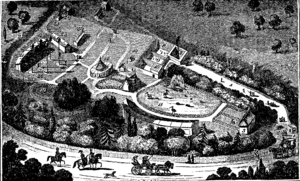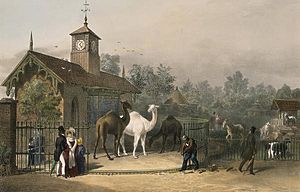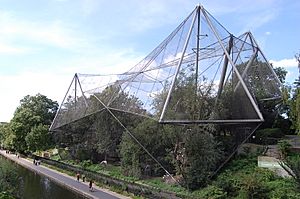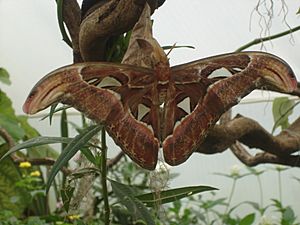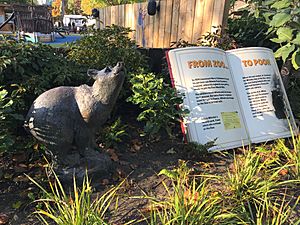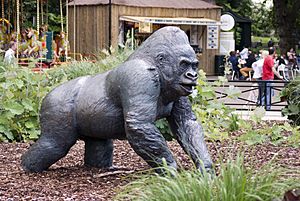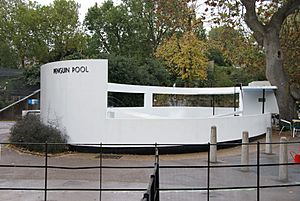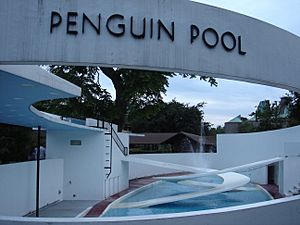London Zoo facts for kids
Logo as it appears on 2021 online map
|
|
| Date opened | 27 April 1828 |
|---|---|
| Location | Regent's Park London, NW1 United Kingdom |
| Land area | 36 acres (15 ha) |
| Coordinates | 51°32′08″N 00°09′21″W / 51.53556°N 0.15583°W |
| No. of animals | 19,289 (2018) |
| No. of species | 673 (2018) |
| Annual visitors | 1,078,519 (2019) |
| Memberships | BIAZA, EAZA, WAZA |
| Major exhibits | Gorilla Kingdom, Animal Adventure, Blackburn Pavilion, Clore Rainforest Lookout, Into Africa, Tiger territory, Land of the Lions and Penguin Beach. |
London Zoo, also known as ZSL London Zoo, is the oldest scientific zoo in the world. It first opened its doors in London on April 27, 1828. The zoo was originally created for scientific study and research.
In 1831 or 1832, animals from the Tower of London menagerie were moved to the zoo. London Zoo then opened to the public in 1847. As of December 2022, it is home to almost 15,000 animals. This makes it one of the largest animal collections in the United Kingdom.
The Zoological Society of London (ZSL) manages the zoo. ZSL was started in 1826. The zoo is located in Regent's Park, with the Regent's Canal running through it. ZSL also has a bigger zoo called Whipsnade Zoo in Bedfordshire. Larger animals like elephants and rhinos have moved there.
London Zoo was not only the first scientific zoo. It also opened the world's first reptile house (1849) and first public aquarium (1853). It also had the first insect house (1881) and the first children's zoo (1938). The zoo does not get money from the government. It relies on memberships, ticket sales, and donations to keep going.
Contents
- History of London Zoo
- Explore the Zoo's Areas
- Monkey Valley
- Land of the Lions
- Tiger Territory
- The Casson Pavilion
- Gorilla Kingdom
- Into Africa
- Rainforest Life and Night Life
- The Outback
- Tiny Giants
- Penguin Beach
- In with the Lemurs
- Meet the Monkeys
- Butterfly Paradise
- Bird Safari
- Blackburn Pavilion
- Gibbon Habitat
- Meerkats and Otters
- Three Island Pond
- Other Animals to See
- Special Entry Programs
- Famous Animals From the Past
- Zoo Architecture
- See also
History of London Zoo
Early Years: 1828 to 1938
The Zoological Society of London (ZSL) was founded in 1826. Sir Stamford Raffles and Sir Humphry Davy started it. They found the land for the zoo. Raffles saw the plans before he passed away in 1826. After him, Henry Petty-Fitzmaurice, 3rd Marquess of Lansdowne took over. He oversaw the building of the first animal homes.
The zoo opened in April 1828 for members of the Society. They could see animals like Arabian oryx and orangutan. It also had animals that are now extinct, like the quagga and thylacine. King George IV gave the Society a special royal charter in 1829. In 1847, the zoo opened to the public to help raise money.
People used to think that tropical animals could not live outside in London's cold weather. So, they were all kept indoors. But in 1902, Peter Chalmers Mitchell became the secretary of the Society. He changed how the zoo was set up. He moved many animals outside, and they did very well. This idea came from Hamburg Zoo. It led to new designs for many buildings.
Mitchell also dreamed of a new, large park north of London. In 1926, land near Whipsnade village was bought. In 1931, Whipsnade Wild Animal Park opened. It was the world's first open zoological park. In 1920, Evelyn Cheesman became the first woman curator at London Zoo.
London Zoo During World War II (1939–1945)
During the Second World War, London Zoo had to close several times. The first time was on September 3, 1939. The government ordered all zoos to close. Important animals were moved to Whipsnade Zoo to keep them safe.
On September 27, 1940, bombs damaged some buildings. These included the Rodent house and the Zebra house. In January 1941, the Camel House was also hit. The aquarium could not open until May 1943 because of the damage. No animals were hurt during these attacks. However, a zebra, a female ass, and her foal escaped during the bombings. Throughout the war, military members paid half price to enter. Wounded soldiers could enter for free.
London Zoo Since 1946
In 1962, an Arabian oryx named 'Caroline' was sent to Phoenix Zoo in the US. This was the first time zoos worked together internationally to breed animals. Today, London Zoo helps with breeding programs for over 130 species.
In the 1980s, London Zoo had 8,000 animals from over 900 species. In the 1990s, it had 7,000 animals from 850 species. Many of these animals, like the wombat and Tasmanian devil, could not be seen anywhere else in Britain. This huge collection was part of the zoo's appeal. But it also caused money problems.
The zoo faced closing down in the 1980s. People's views on animals in captivity changed. Also, the animal spaces were too small. This led to fewer visitors. But when it was announced that the zoo would close in 1991, there was a huge wave of public support. People visited more and gave donations. This allowed the zoo to stay open. It began the big job of fixing its buildings. It also created better homes for the animals.
During the COVID-19 pandemic in 2020, the zoo closed for a few months. This caused serious money problems. The Snowdon Aviary was rebuilt as Monkey Valley. It opened in 2022.
Explore the Zoo's Areas

London Zoo has many special areas and attractions. Some of these can be rented for events when the zoo is closed. These include Penguin Beach and Land of the Lions.
| Animal Group | Number of Species | Number of Individuals |
|---|---|---|
| Mammals | 70 | 561 |
| Birds | 99 | 671 |
| Reptiles | 49 | 167 |
| Amphibians | 20 | 726 |
| Fish | 207 | 5818 |
| Invertebrates | 228 | 11346 |
| Total | 673 | 19289 |
Monkey Valley
The Snowdon Aviary was designed by Cedric Price, Frank Newby, and Antony Armstrong-Jones, 1st Earl of Snowdon. It was built between 1962 and 1964 and opened in 1965. It was Britain's first walk-through aviary. It mainly housed shorebirds like gulls.
The structure is a pyramid-shaped aluminum frame, 21 meters high. In 2021, the aviary was turned into "Monkey Valley". This is a walk-through area for primates. It opened in August 2022. It is now home to a group of eastern black and white colobus monkeys. The building has been a Grade II* listed building since 1998.
Land of the Lions
Land of the Lions is where London Zoo's Asiatic lions live. It opened in 2016. The area is 2,500 square meters. It looks like an Indian town next to the Gir Forest National Park. This shows how the lions' natural home is close to human towns. You can also see Hanuman langurs, small Indian mongooses, and Rüppell's vultures here.
Tiger Territory
Tiger Territory is the home of London Zoo's Sumatran tigers. Architect Michael Kozdon designed it. The Duke of Edinburgh officially opened it in March 2013. The zoo currently has four tigers. There is a male named Asim, a female named Gaysha. They also have two cubs born in June 2022, named Zac and Crispin.
The tiger home is 2,500 square meters (27,000 square feet). It has real Indonesian plants. A net canopy made of steel cable is supported by four metal poles.
The Casson Pavilion
The Casson Pavilion is a Grade II listed building at the zoo. Sir Hugh Casson designed it between 1962 and 1965. It was first built for rhinos and elephants. But these animals moved to Whipsnade Zoo in 2001. Now, the building houses camels and porcupines. It was also part of Tiger Territory for a while. It held bearded pigs and Malayan tapirs. Now, it is its own exhibit called The Cassons. It is home to a family of red river hogs and babirusas.
Gorilla Kingdom
The Duke of Edinburgh opened Gorilla Kingdom in March 2007. It has an island surrounded by water. This island is home to a group of western lowland gorillas. The zoo currently has seven gorillas. There is an adult male named Kiburi. Two adult females are Mjukuu and Effie. There is a young female named Alika, born in December 2014. A young male named Gernot was born in November 2015. An unnamed baby gorilla was born to Mjukuu in January 2024. Another baby was born to Effie in February 2024.
Gorilla Kingdom also has smaller homes for white-naped mangabeys and Diana monkeys. There is also a walk-through aviary with African birds.
Into Africa
Into Africa is an Africa-themed area. It opened in April 2006. Here you can see Chapman's zebras, common warthogs, okapis, common ostriches, giraffes, pygmy hippos, and African wild dogs. London Zoo's Giraffe House was built in 1837. It is the oldest zoo building in the world still used for its original purpose. The Giraffe House is a Grade II listed building.
Rainforest Life and Night Life
Rainforest Life is an indoor exhibit you can walk through. It has many animals from South American rainforests. You can see Linnaeus's two-toed sloths, golden lion tamarins, and red-faced spider monkeys. Other animals include big hairy armadillos and Rodrigues flying foxes.
The building also has a dark area called "Nightlife". This area is for animals that are active at night. You can find Mohol bushbabys, slender lorises, aye-ayes, and blind cave fish here.
The Outback
The Mappin Terraces opened in 1913. It has a fake rocky cliff made of concrete blocks. This was the zoo's first big try at making natural-looking homes without bars. Many different animals have lived here. These include bears, penguins, and kangaroos.
The Mappin Terraces is now an Australia-themed exhibit called "The Outback". It is home to emus and red-necked wallabies.
Tiny Giants
Tiny Giants, once called B.U.G.S., is an exhibit for small creatures. It has invertebrates and fish. It is in a building called The Millennium Conservation Centre. This building shows over 160 species. These include western honey bees, leafcutter ants, and emperor scorpions. You can also see Mexican redknee tarantulas and moon jellyfish.
It also has a large coral reef aquarium. This tank has corals and over 200 reef fish. The Millennium Conservation Centre is designed to be good for the environment. It uses materials that need little energy to make. It even gets heat from the body warmth of animals and visitors. In May 2015, "In With the Spiders" opened. It is Europe's first spider walk-through exhibit. It has many types of spiders, including the fen raft spider. This is one of the UK's most endangered animals.
Penguin Beach
Penguin Beach opened on May 26, 2011. It is home to Humboldt penguins. A male northern rockhopper penguin named Ricky also lived there. He moved to Whipsnade Zoo in March 2017. The pool at Penguin Beach is the largest penguin pool in an English zoo.
In with the Lemurs
In with the Lemurs opened in March 2015. It is a walk-through exhibit. It is home to a group of ring-tailed lemurs and Lac Alaotra bamboo lemurs. It also has a family of aye-ayes and lesser hedgehog tenrecs indoors. The exhibit looks like a shrub forest in Madagascar. It has plants like loquat and Chusan palm trees.
Meet the Monkeys
Noel Fielding and Julian Barratt opened Meet the Monkeys in 2005. It is a walk-through area. It is home to a group of black-capped squirrel monkeys. There is no roof, and no barriers between the monkeys and visitors. It is the southernmost animal area in the zoo.
Butterfly Paradise
Butterfly Paradise opened in May 2006. It has many different kinds of butterflies and moths from around the world. It also has special plants for the insects to eat and lay eggs on. You can see the clipper butterfly and blue morpho butterfly. Other species include the atlas moth and glasswing butterfly. The exhibit also has a caterpillar hatchery. You can see different types of pupae and watch new butterflies grow.
Bird Safari
The Bird Safari opened in 2005. It was a new version of the old stork and ostrich house. It replaced old enclosures. It is a walk-through exhibit for various birds. These include waldrapp ibises and Abdim's storks. You can also see great arguses and scarlet ibises.
Blackburn Pavilion
The Blackburn Pavilion is a tropical bird aviary. It has a rainforest theme. It opened in March 2008. It was an update of the zoo's old bird house. It now allows visitors to walk through. The building was first built in 1883 as a reptile house.
The pavilion is home to about 50 different kinds of exotic rainforest birds. These include blue-crowned laughingthrushes and collared trogons. You can also see red-crested turacos and red-and-yellow barbets. Outside the entrance is a large, detailed clock by Tim Hunkin. It has a bird-themed show every thirty minutes.
Gibbon Habitat
The Gibbon Habitat is a new home for the zoo's two gibbons. It has two viewing spots. One is at ground level near the camel area. The other is higher up, from Tiger Territory. One gibbon is a northern white-cheeked gibbon. The other is a mix of species. They used to live in Gorilla Kingdom.
Meerkats and Otters
Meerkats and Otters has two areas. One is for Asian small-clawed otters. The other is for meerkats. This exhibit was first made for meerkats, otters, and other animals. The reindeer later moved to Whipsnade Zoo. The monkeys moved to the zoo's Rainforest Life building.
Three Island Pond
Three Island Pond became an official exhibit in 2021. This pond has three islands. It is divided into two parts. One part is home to greater flamingos. The other part has Eastern white pelicans.
Other Animals to See
Other interesting animals at London Zoo include Bactrian camels. You can also see different types of macaws. These include hyacinth macaws and blue-throated macaws. The zoo also has Alaotran gentle lemurs.
Special Entry Programs
In 2019, London Zoo started a Community Access Scheme. This program offered 100,000 cheaper tickets. These tickets were for charities and groups helping low-income families, older people, and disabled people. This program was supposed to run until 2023. It started with money from the National Lottery Heritage Fund. This money helped turn the Snowdon Aviary into a colobus monkey home.
The program was very successful. It was later expanded. Now, anyone who gets certain benefits can buy tickets for £3. This is about one-tenth of the full price. Thousands of families have visited because of this. There were long lines, so the zoo now requires booking tickets ahead of time. The zoo's director general said the program was a "brilliant development."
Famous Animals From the Past
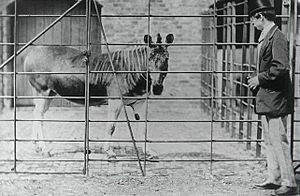
Throughout its history, London Zoo has had many well-known animals. Some were important for science. Others were simply loved by the public.
Old Martin was a very large grizzly bear. He was the first grizzly bear in Britain. He moved to the zoo in 1832 when the Royal Menagerie, Tower of London closed.
The zoo was home to the only living quagga ever photographed. This animal became extinct in the wild around 1870. Another extinct animal the zoo had was the thylacine, also called the "Tasmanian tiger."
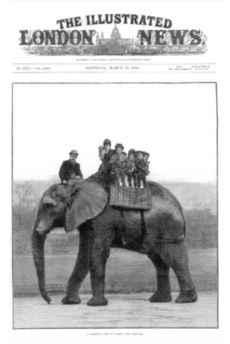
Obaysch was the first hippopotamus seen in Europe since Roman times. He arrived at London Zoo in May 1850. He was a gift from the ruler of Egypt. Obaysch made the number of visitors to the zoo double that year.
In 1865, Jumbo the elephant came to the zoo from Paris. He was the largest elephant known at the time. His name, possibly from the Swahili word for 'hello', became a word for anything very big. Jumbo was a favorite with visitors. He would give rides to children, including those of Queen Victoria. When Jumbo was sold to Phineas Barnum's circus in 1882, Londoners were very upset. 100,000 schoolchildren wrote to the Queen to stop the sale.
Winnipeg the Bear (or Winnie) was an American black bear. A Canadian soldier, Harry Colebourn, gave her to the zoo in 1914. A. A. Milne visited with his son Christopher Robin. The boy loved the bear so much that Milne wrote the famous Winnie-the-Pooh books. A 2004 movie, A Bear Named Winnie, tells Winnie's story.
Mo Koundje ('Mok') was a western lowland gorilla. The zoo bought him in 1932. A new gorilla house was built for him. Mok passed away in 1938.
Guy, another western lowland gorilla, arrived at the zoo in 1947. He lived at the zoo until 1978. He became one of the zoo's most loved animals. In 1969, a female gorilla named Lomie arrived. They got along well but never had babies. In 1982, a bronze statue of Guy was placed in Barclay Court.
Dumbo (born 1948) was a female Indian elephant. She lived at London Zoo in the 1950s. She was known for loving sweets. Her parents were killed by hunters. She traveled from India to England by plane. She spent her life giving rides to children. Dumbo was named after the Disney character because she was the first elephant to travel by airplane. In 1958, she moved to Moscow Zoo.
On November 27, 1949, Brumas became the first polar bear born at the zoo. She became a huge attraction. The zoo's visitors went up to over 3 million in 1950. This number has not been beaten since.
One of the zoo's most famous giant pandas was Chi Chi. She arrived in 1958. She was supposed to go to an American zoo. But the US had stopped trading with China. So, Chi Chi was not allowed into the US. ZSL usually did not get wild pandas. But since Chi Chi was already collected, they bought her. She became the main attraction. Chi Chi was the only giant panda in the west. She inspired Peter Scott's design for the World Wildlife Fund logo. Chi Chi passed away in July 1972, and many people were sad.
The zoo's last giant panda was Ming Ming. She came in 1991 for breeding. After trying to breed with Berlin's panda, she was sent back to China. London Zoo has not had a giant panda since 1994.
In August 2005, the zoo had an exhibit called the Human zoo. Eight humans were on display in the Mappin Terraces. The idea was to show how humans are also animals. It also looked at how we affect the animal kingdom.
Zoo Architecture
From its start, the zoo has chosen top architects to design its buildings. Today, it has two Grade I and eight Grade II listed structures.
Decimus Burton was the zoo's first official architect from 1826 to 1841. He designed the Clock Tower in 1828. In 1830, the East Tunnel was finished. It connected the north and south parts of the zoo. It also served as a bomb shelter during the Second World War. Burton finished his work in 1837 with the Giraffe House. It is still used today in the Into Africa exhibit.
The oldest building still standing is the Ravens' Cage. It is a fancy iron bird cage. It was put in place in 1829. Its location has changed, and it has been fixed up many times.
The Eastern Aviary was built in 1863. It has a steel frame. It was updated in 1989 with 'invisible' wire.
The Stork and Ostrich House, built in 1896, can still be seen. It is behind the current Bird Safari exhibit. Some old buildings have been taken down. These include the Lion House and Monkey House.
After Burton, Sir Peter Chalmers Mitchell and John James Joass designed the Mappin Terraces. They were finished in 1914. The Mappin Terraces look like a mountain. They provide a natural home for bears and other mountain animals.
In 1933, the Round House was built for gorillas. It was designed by Berthold Lubetkin's Tecton Architectural Group. It was one of the first modernist buildings in Britain. The next year, the Penguin Pool also designed by Tecton, was opened. Both are now Grade I listed. The Penguin Pool's concrete ramps are famous for their modern design. But in 2004, the African penguins moved out. Walking on the concrete caused foot problems for the birds.
The Snowdon Aviary was built in 1964. It used new ways of building with aluminium and tension for support. A year later, the Casson Pavilion opened. It was designed by Sir Hugh Casson. It was built to show elephants and rhinos in an exciting way. It was designed to look like a group of elephants around a watering hole.
Many of these buildings can be rented for private events. The money from these events helps the Zoological Society.
See also
 In Spanish: Zoológico de Londres para niños
In Spanish: Zoológico de Londres para niños


